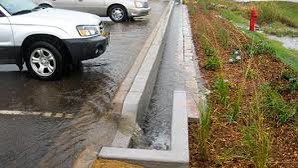Level spreaders
Jump to navigation
Jump to search

The printable version is no longer supported and may have rendering errors. Please update your browser bookmarks and please use the default browser print function instead.

This clever design incorporates a level spreading device after a curb cut has narrowed the flow path. This kind of treatment train approach would provide an opportunity to provide pretreatment at the point of concentration. Photo credit: MPCA
Level spreaders should conform to the following design criteria in order to ensure non-erosive sheet flow into vegetated areas such as vegetated filter strips, bioretention, swales or forested conservation areas[1].
The length of the level spreader should be determined by the design storm inflow rate and type of landscape downstream:
- 1.4 m of level spreader length per every 0.01 m³/s of inflow when draining to a vegetated filter strip, bioretention, swale or grassed area;
- 4.3 m of level spreader length per every 0.01 m³/s of inflow when draining to a forested conservation area.
- The minimum level spreader length is 4 m and the maximum is 40 m.
- The level spreader lip should be concrete, wood or pre-fabricated metal.
- The ends of the level spreader section should be tied back into the slope to avoid overflow scouring or erosion around the ends.
- The width of the level spreader should be the greater of 300 mm or three times the diameter of the inflow pipe.
- The depth should be the greater of 200 mm or half the inflow pipe diameter.
References[edit]
- ↑ Hathaway, J. M., & Hunt, W. F. (2006). Level Spreaders : Overview , Design , and Maintenance.
